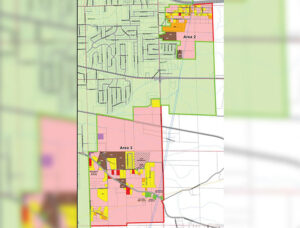COLUMBUS — City school officials have had enough.
Following the ninth bomb threat of the school year last week, the Columbus Municipal School District Thursday hosted a safety summit, with local agencies and a national technology expert, trying to develop better strategies of threat assessment and response.
Deputy Superintendent Craig Shannon estimated 26 hours of instruction time have been wasted in the district, this school year, while students huddled on football fields, in church sanctuaries and at other evacuation sites, waiting for law enforcement personnel to search the schools and give the all-clear for students’ return.
Columbus High School has taken the brunt, losing 14 hours of instruction time which must be made up, Shannon told the crowd of around 40 school officials, administrators, law enforcement and emergency first responders.
The high school received bomb threats March 6, Feb. 22, Feb. 16 and Jan. 27. Columbus Middle School had a threat Sept. 16, and Fairview Elementary Aerospace and Science Magnet School had threats March 19 and March 9. The schools each lost six hours of instruction time.
New Hope High School, in the Lowndes County School District, also received two bomb threats this year.
In each case, no explosives were found and officials established the calls — some of which were from juveniles — were pranks. That’s typically the case, Shannon said. But even if a threat is believed to be a hoax, schools and first responders have few alternatives to evacuating the targeted school.
“You don’t get a second chance,” Shannon said. “We’re not going to make mistakes with your children.”
The threats, which are a felony to make, take a toll on local responders as well.
Columbus Police Chief Selvain McQueen noted he sends seven or eight officers to the threatened school. The Columbus Air Force Base sends military working dogs and their handlers to perform safety sweeps. Columbus Fire and Rescue sends trucks and crews, who idle in the parking lot, waiting for the threat to be cleared. The whole process can take four to six hours depending on the size of the school and the length of time it takes for a bomb squad to arrive and conduct the search.
But what if a six-hour job could become a two-hour job?
That’s the question CMSD Interim Superintendent Dr. Martha Liddell began asking a few months ago. Her research led to both a practical, in-house strategy, as well as an innovative technology solution, which could eventually become standard in the schools of the future.
‘Prevention is
absolutely key’
The easiest way to cope with school safety threats is to stop them before they happen, Shannon said. And the best way to do that begins with the students themselves.
Every student should have an adult on campus in whom they feel comfortable enough to confide, he said. Typically, students know what’s happening — or might happen — before anyone else. If a student is considering calling in a threat as a prank, they’re going to tell someone or it’s not any fun, Shannon said. And their peers will spill the secret every time.
Students need to feel like they can talk to administrators and they will be heard, he said. Whether a threat is real or not, they believe it to be real, and it must be taken seriously.
Cell phones are a growing problem also, Shannon added. Parents want children to have the phones for safety reasons, but when they interrupt school, it becomes an issue. At the high school, the first time a student’s cell phone is taken away, it is returned at the end of class. The second time, it’s returned at the end of the semester. The third time, it’s returned at the end of the year. It infuriates parents paying the cell phone bill, but the rules exist to protect the learning process as well as the students, he said.
“Prevention is absolutely key,” Liddell added.
‘You don’t get but one time to mess up’
The district is implementing a bomb threat response team at every school. The principal will lead the team and coordinate the response. The team will be empowered with training and permission to quickly assess threats and make decisions, without having to wait for officials from the district’s central office.
“It takes (us) 15 minutes to get to the other side (of town),” Shannon said. “There’s no time for anyone to wait for us to make a decision.”
Pre-determined communication methods are established at each school, as well as secondary communication methods. Teams will be trained to recognize suspicious items and perform safety sweeps. Law enforcement and emergency officials still will respond; the goal is to quicken the process and get students to safety faster and back in the classrooms sooner.
Additional plans will be established to deal with threats during field trips, while students are on school buses and during special events.
Also, only adults will be allowed to answer school phones and those adults have a procedure to follow if a threat is received. Shannon noted the district also implemented call-tracing technology.
“You don’t get, but one time to mess up,” Shannon said.
Next-generation
solutions
District officials also got a first look at a technology-based solution. Robert Vashisth, co-founder of Tridex Solutions of Salt Lake City, Utah, delivered a presentation on hardware and software technologies, which would allow authorized persons to quickly assess threats and deal with them.
The hardware allows users to monitor structures remotely in real time and the software allows thermal mapping, which could be used in multiple ways, including identifying suspicious people and virtually following them, as they move throughout the building. It can be used by first responders as they are en route to the scene, saving valuable time, he said.
School officials said they would research school safety grants available to fund the technology.
The district will hold its next safety summit April 13 at Brandon Central Services, at which Mississippi Department of Education officials are expected to speak.
Carmen K. Sisson is the former news editor at The Dispatch.
You can help your community
Quality, in-depth journalism is essential to a healthy community. The Dispatch brings you the most complete reporting and insightful commentary in the Golden Triangle, but we need your help to continue our efforts. In the past week, our reporters have posted 37 articles to cdispatch.com. Please consider subscribing to our website for only $2.30 per week to help support local journalism and our community.






